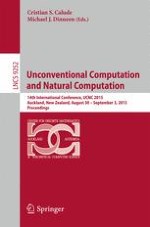This book constitutes the refereed proceedings of the 14th International Conference on Unconventional Computation and Natural Computation, UCNC 2015, held in Auckland, New Zealand, in August/September 2015. The 16 revised full papers were carefully reviewed and selected from 38 submissions. The papers cover a wide range of topics including among others molecular (DNA) computing; quantum computing; optical computing; chaos computing; physarum computing; computation in hyperbolic spaces; collision-based computing; cellular automata; neural computation; evolutionary computation; swarm intelligence; nature-inspired algorithms; artificial immune systems; artificial life; membrane computing; amorphous computing; computational systems biology; genetic networks; protein-protein networks; transport networks; synthetic biology; cellular (in vivo) computing; and computations beyond the Turing model and philosophical aspects of computing.
